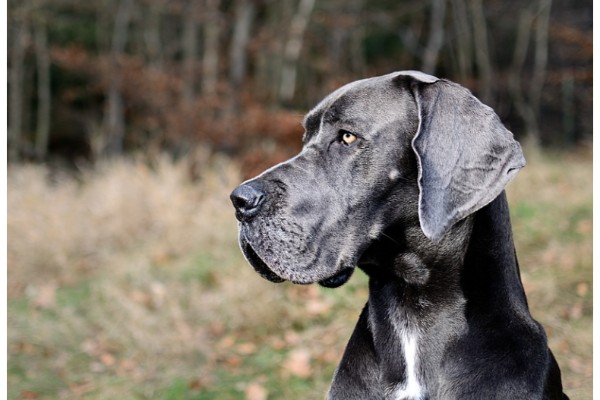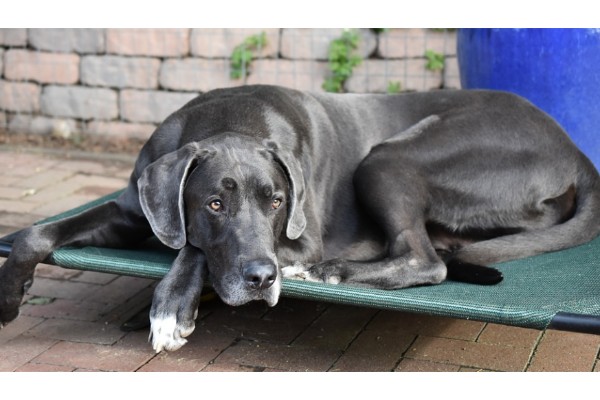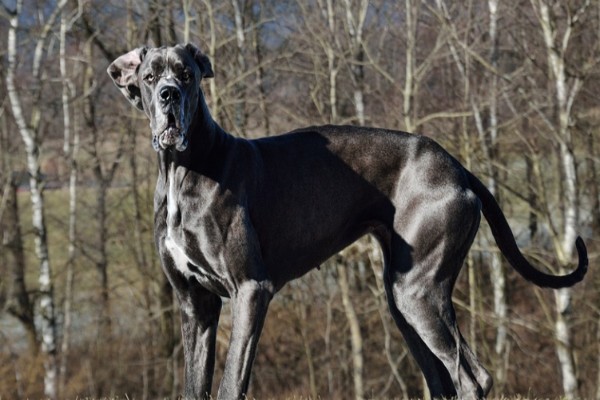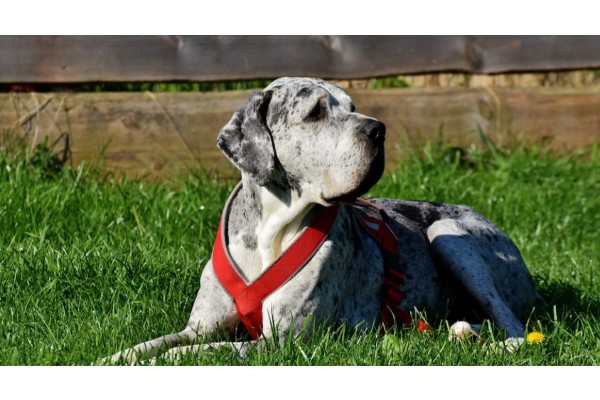Yes, Great Danes shed. Even though Danes appear to have short hair, this does not necessarily mean that they shed less.
They don’t have as many problems as a fluffy breed with a thick undercoat, such as a teacup husky or a fluffy Frenchie. Danes, however, are still subject to the same shedding cycle that most dogs go through a few times a year.
It can be difficult to avoid dog dander if you or someone in your home is allergic to dogs. However, by taking a few easy measures, you can lessen the annoyance.
Table of Contents
How Much Does Great Danes Shed?
It is true that Great Danes shed. As moderate to heavy shedders, Great Danes are. You should anticipate finding some dog hair in your home if you adopt one.
The type of dog’s coat significantly affects how much it sheds. Dogs can have single coats with just one layer of fur, or double coats with a thicker undercoat and a finer top coat. Double-coated dogs shed more than single-coated breeds because they have two layers of fur, which they add to during the two seasonal shedding periods.
You don’t have to worry about seasonal shedding because the Great Dane is a single-coated dog breed.
The bad news is that despite their enormous size, Great Danes still shed a lot of hair. Simply put, there is more surface area covered in dog fur, which leads to more loose hair in and around your home.

Why Great Danes Shed?
Great Danes do shed, as I’ve previously mentioned. All dogs do, in fact, shed, with the exception of breeds that lack hair. It’s the natural process for dogs to get rid of old or damaged hair, though some dogs shed more than others.
Dog coats come in two varieties: single coats and double coats. A dog with a double coat has two layers of fur instead of one and sheds more hair as a result. Double-coated dogs, therefore, need a lot more grooming.
Fortunately for Great Danes (or rather their owners), they have a smooth and short single coat. The coat requires little maintenance and is comparatively simple to groom. However, Great Danes shed more hair during the spring and moderately throughout the year.
Why Great Danes Shed A Lot
You already know that Great Danes shed their single coat moderately to heavily. However, Great Danes seem to shed more than other breeds with a similar single coat. Why is this the case, you may be asking.
Actually, it’s very easy. Great Danes are huge! It feels like they shed more than other single-coated dogs simply because they are larger and have more fur. More “surface” area means more opportunities to shed fur.
This is something to keep in mind when picking a pet. If you own a Great Dane, there will probably be a lot of hair on your clothes, carpets, and furniture.
Excessive Hair Loss in Danes
You can’t stop your dog from losing hair unless it’s in its DNA because losing hair is a natural process. Just to name a few examples of dogs that don’t shed are Shih Tzu dogs and poodles Nevertheless, they experience hair loss just like humans do.
Hair loss varies by breed in terms of frequency and volume. However, the individual dog’s diet and health can also play a role in shedding. Excessive hair loss usually means something not quite right. Actually, it’s a sign of a variety of health issues.
Cruzen recommends that quality dog food should cost roughly $4 per pound. Most commercial dog food barely meets the minimum requirements. However, most dogs typically need more than the minimum. Owners notice odd shedding as a result.
Excessive shedding could also be caused by allergies in some dogs. Consult your veterinarian right away if your Great Dane is experiencing excessive shedding during the typical months. Usually, it can be explained logically and biologically.
The Great Dane’s Shedding Phases
When considering shedding, a frequent question is often “why do dogs have fur?” As with many animals, fur is there to help the dog keep a constant body temperature. The animal is shielded from the elements, including the sun, heat, and cold.
But every hair eventually stops growing or becomes damaged, which causes it to fall out. In its place, new hair grows. Every dog has a growth cycle with multiple phases, just like your own hair follicles do. These are:
1. The Growing Phase (Anagen Phase) – This is the time of the hair cycle.
2. The Transition Phase (Catagen Phase) – The hair stops growing at this point. During this stage, the dermal papillae-attached hair follicles contract and separate.
3. The Resting Phase (Telogen Phase) – Both hair growth and shedding are nonexistent. Fresh hair begins to grow at this point.
4. The New Hair Phase (Exogen Phase) – When this happens, the old hair falls out and is replaced by new hair.
Breeds differ in the order in which these phases occur. For example, Poodles and other low-shedding dogs spend longer in the first phase. Since they don’t shed as much as dog breeds like Great Danes, they are.
The thickness of the coat also depends on the season. A dog’s coat will be thinner when it is warmer and there are more daylight hours. For this reason, as the weather warms up and the days grow longer, there is more shedding in the spring.

How To Minimize Shedding In Danes
Even though it keeps your Great Dane looking its best, maintaining your dog’s coat isn’t just about appearances. Less dry skin means fewer dead hairs, which translates to a healthy coat. You won’t have to pick up as much loose fur because there will be less shedding overall.
Here’s how to make sure your Great Dane’s coat stays healthy:
Regular Brushing
To prevent loose hair from flying around the house, brush your Great Dane’s fur with a bristle brush. Additionally, regular grooming aids in distributing natural skin oils to all of the hair follicles in the coat, keeping the hair moisturized and minimizing shedding even more.
Regular Bathing
Your Great Dane probably won’t need to be bathed all that frequently, and bathing a dog too frequently can actually dry out the skin and cause more shedding. However, giving your dog a bath every few months or so is another effective way to keep its fur in good condition. (Use only dog shampoo because it is designed specifically for our furry friends.)
We are aware that bathing a Great Dane can be quite a task due to the breed’s extra-large size. When it’s time for a bath, enlist the aid of a relative, or a friend, or even go to a nearby dog groomer.
Proper Nutrition
Feeding their Great Danes well is another way for owners to maintain their dogs’ healthy coats and minimize shedding. That’s because healthy eating promotes healthy skin, which results in a healthy coat with less hair loss.
Find out from your veterinarian if the food you are feeding your dog is appropriate. If it’s not, you should switch to a premium food that gives your Great Dane all of the necessary nutrients.
Another way to ensure that the diet you give your dog keeps its coat in good condition? Add Native Pet’s Omega Oil as a supplement to it for the benefit of the skin and coat, as it is bursting with omega-3 fatty acids. Omega-3 fatty acids can also help your dog’s heart and joints.
Preventative Medications
Have you suddenly noticed that your dog is shedding excessively? There may be a health problem at play. Parasites are one of the most frequent problems that harm our dogs’ coats. If fleas, ticks, mites, and lice aren’t treated, they can result in hair loss and other severe symptoms.
Visit your veterinarian to obtain medications that will help your dog avoid contracting worms, fleas, ticks, and other parasitic pests, or to receive treatment if an infestation has already occurred. The best way to keep your dog healthy and free of pests over the long haul is simply by using preventative measures, though there are some natural remedies for fleas and other pests that can be effective.
Are Great Danes Hypoallergenic?
No, Great Danes are definitely not hypoallergenic.
The truth is that if a person has allergies to the allergens that dogs produce, any dog on the planet, even hairless breeds, can make them worse.
And the reason is that these allergens don’t originate from the hair itself; rather, they originate from the dander (dead, flaky skin) and dried saliva of the dog. Additionally, these allergens adhere to the dog’s coat. Therefore, when they shed, the allergen that makes you sneeze gets into more rooms in your house.
To put it another way, no dog is completely hypoallergenic, but low-shedders are typically regarded as being more hypoallergenic than high-shedders. Furthermore, Great Danes are not regarded as hypoallergenic because they do shed quite a bit.
Is Great Danes Good For Adoption?

Huge dogs like the Great Danes are bred. They are actually the tallest breed of dog in existence. They have a laid-back, easygoing nature, though, and are equally gentle.
They make wonderful family pets and genuinely love people. Despite their size and potential intimidation, they usually get along well with children and dogs of all breeds.
Great Danes were bred to hunt wild boars in Germany in the 1800s, according to their origin story. They were often referred to as the “Apollo of Dogs”, the Greek god of the sun and light; named after them likely due to their size and strength.
Who would benefit from them most? Great Danes are wonderful family pets. They don’t bark a lot either, so the neighbors won’t be bothered. Despite being content to laze around the house with the family, they are probably best suited to someone with a yard given their size and the fact that they require regular exercise.
Just be aware that they eat more than the majority of people do and often go back for more.
In either case, the Great Dane is a good choice if you don’t mind shedding and want a low-maintenance family pet who will also be a responsible watchdog.
FAQs
How Much Hair Do Great Danes Lose?
Great Danes shed hair on a moderate to a high level throughout the year, but this is simple to control by giving them a regular brushing with a bristle brush or a rubber hand mitt.
Are Great Danes Barkers?
Great Danes are generally the opposite of breeds like the Beagle in that they don’t bark much. They generally only bark when there is a real need to do so and are cool, calm, and collected.
Do Great Danes Get Along Well With Kids?
Great Danes make wonderful family pets and, as a breed, are typically very good with children despite their enormous size and somewhat intimidating appearance.
Similar Breeds That Shed Less?
The Airedale, Scottish Deerhound, Saluki, and Black Russian Terrier are additional large dog breeds that shed less hair. However, some of these will need more grooming time and have different temperaments, so ultimately it comes down to your personal preference.
